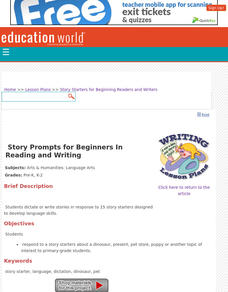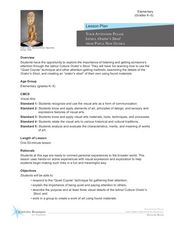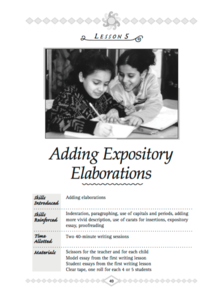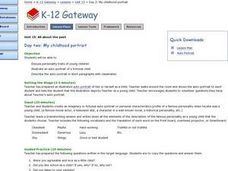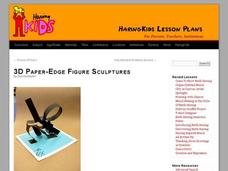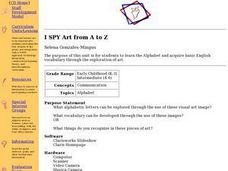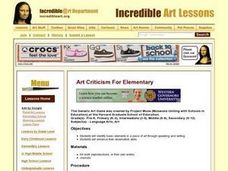Curated OER
Women
A close study of two works of art provides the introduction to this cross-curricular writing assignment. After comparing the clothing, facial expressions, body language, setting, and color in the two 19th century paintings Tissout’s...
Curated OER
Say Hello! Around the World
Hello! Bonjour! Paivaa! Ni hao! Teach learners of all ages how to say hello in several different languages. There are project ideas for younger learners and older learners. Kids love learning a different language, even if it's just this...
Curated OER
Story Starters for Beginning Readers and Writers
Young scholars respond to a story starters about a dinosaur, present, pet store, puppy or another topic of interest to primary-grade students. They dictate or write stories in response to 15 story starters designed to develop language...
Curated OER
Book Illustrations and Their Illustrators as Artists-K-3
Help learners construct relationships between written narratives and book illustrations, and between the narratives in formal visual art and the subject of the visual art. Look at Caldecott winning books and focus on the pictures drawn....
Curated OER
Children's Literature Across the Curriculum Ideas-How Dogs Really Work!
Students read How Dogs Really Work! by Alan Snow. They complete a variety of cross-curricular activities surrounding the study of dogs as pets. Included are reading, art, math, science, writing, social studies, and library connections.
NWT Literacy Council
Readers Theatre Scripts
Engage and entertain young learners with this collection of readers theatre activities. With over 25 different scripts, a wide range of topics are covered from simple counting and rhyming exercises to adaptions of popular children's...
Curated OER
Your Attention Please: Iatmul Orator's Stool
Students investigate art by observing historical sculptures from New Guinea. In this art history lesson, students observe pictures of the "Orator's Stool"from Papua New Guinea, while identifying the small details that make it unique....
Curated OER
Are or Our?
Are and our are two of the most commonly misused words in the English language. This presentation tries to address that fact. And it does! The different uses of these two words is clearly explained. A clever slide closes the...
Curated OER
Gingerbread Baby's Point of View #8
Read the story Gingerbread Baby and use these various activities to connect to grammar, art, and point of view. In one activity, learners create character masks. They practice writing verbs on the back of the masks to tell what each...
Curated OER
Contraction Twins
Discuss contractions using this simple presentation. Focusing on contractions, such as I'm, it's, I'll, and isn't, this resource could provide a great way to introduce the topic. You could also use it as a way to review material before...
Curated OER
Week 15 'dge'
The 'dge' blend is quite common in our language. This presentation is for young readers who are just learning this blend. Many examples are given, and there are lots of opportunities to practice reading this important consonant/vowel blend.
Curated OER
Pippa's Journey
This unique presentation is a children's story written by a teacher. The last slide of the presentation tells you of the history behind the story, and how it is used to teach her own students the art of story writing.
Scholastic
Adding Expository Elaborations
How can you tell if a prompt is expository or narrative? Help your learners identify key words in writing prompts to determine how they should craft their essays.
Curated OER
My Childhood Portrait
Students practice descriptive writing by viewing auto-portraits of young children. In this art analysis lesson plan, students examine an auto-portrait of their teacher as a young child and ask him/her questions about their youth....
Curated OER
English Grammar Verbs
For this verbs worksheet, students complete filling a chart with present tense verbs, past tense verbs and irregular verbs with "ed" and/or "ing".
Curated OER
Gyotaku Lesson Plan
Learners study the Japanese art of fish painting called Gyotaku while examining the lifestyle of Japanese fishermen at the end of the Edo period. They make a Gyotaku fish print and write a haiku poem using the proper number of syllables...
Curated OER
3D Paper-Edge Figure Sculptures
Students discover visual arts by creating sculptures in class. In this personal expression instructional activity, students research the Internet and examine different examples of modern sculptures and 3 dimensional art. Students utilize...
Curated OER
Interview
English learners practice basic conversation skills with a worksheet that exercises progressive/continuous verb forms. They conjugate given words to form correct sentences. Their partner does the same. They ask each other the questions...
Curated OER
I SPY Art from A to Z
Students explore the Alphabet and acquire basic English vocabulary through the exploration of art. They find the alphabet in a variety of visual art images the teacher provides for them. Students count, sort and categorize Alphabet...
Curated OER
Say "Thank You" in 100 Languages!
Young scholars put the "Thanks" back in Thanksgiving with this geography and language activity that teaches students to say "thank you" in many languages.
Curated OER
Language Practice
In this language worksheet, students answer questions about real or make believe, spelling, editing, and choosing the correct word. Students complete 4 problems.
Curated OER
Art Criticism for Elementary
Students view various pieces of art and identify their basic elements. Using the art, they present the elements to the class in a presentation. They answer questions and organize them into written form. They also write and reflect on...
Curated OER
Using Onomatopoeia to Tell the Story of an Imaginary Field Trip
Students explore language arts by utilizing word choice to compose a paragraph. In this phonetics lesson, students discuss the importance of a "voice" in their writing as they read the book Rattletrap Car. Students write paragraphs about...
Curated OER
Camel Similes
In this language arts activity, students learn that similes compare 2 things using the words like or as. Students write 5 similes about camels and then illustrate one of them.
Other popular searches
- English Language Arts
- English Language Arts Exam
- English Language Arts Games
- Deaf English Language Arts
- English Language Arts Music
- English Language Arts Heroes
- English Language Arts Skills
- English Language Arts Grade 3
- English/language Arts
- English Language Arts Poetry
- English Language Arts Rating=3
- English Language Arts Unit Sc


